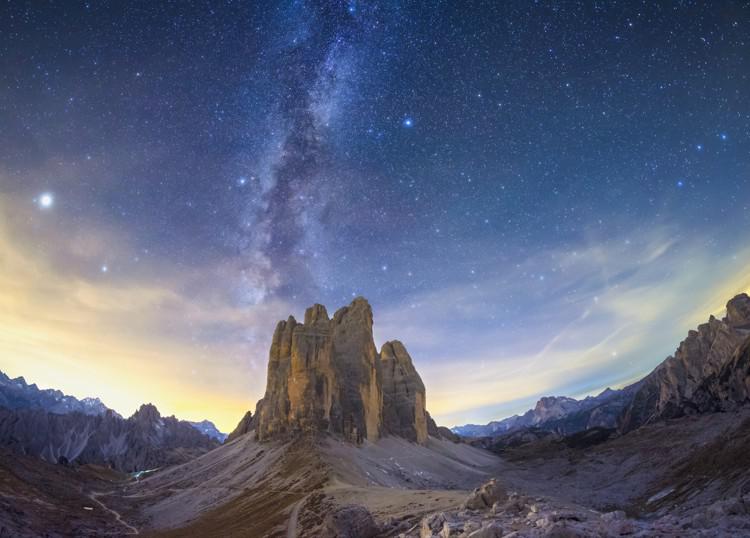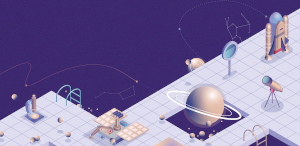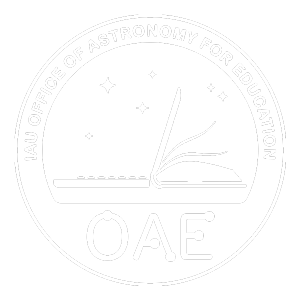This page describes an image The Pillar of Creation
Image caption:
Winner in the 2022 IAU OAE Astrophotography Contest, category Still images of celestial patterns.
This image shows the night sky over Tre Cime di Lavaredo, (Dolomites Natural Park), in the region of Veneto, Italy, in October 2021.
The bright spot on the left-hand side is the planet Jupiter, appearing in the constellation Capricorn. To the right of Jupiter and below the two horn stars of Capricorn is the planet Saturn. Just above Jupiter we can see parts of Aquarius, one of the largest constellations and also part of the Zodiac. North of these constellations, left of the Milky Way, there are mostly faint stars. The brighter whitish one in the top left corner is Enif, a binary star in the constellation Pegasus.
The Milky Way seems to emerge from a rock like celestial vapour. Roughly centred in the image are two bright stars left and right of the Milky Way: Altair and Vega, respectively. They seem to be separated by the galactic stream, as told in a popular Chinese folk story where they represent a loving couple. Today, in popular astronomy, the fairly bright star at the upper edge of the photograph is added to form a huge triangle with them, the Summer Triangle in the northern hemisphere.
Altair is the brightest star of the Babylonian constellation Aquila, the Eagle. In ancient Babylon, it was said that the Eagle was carrying king Etana up in the air so that he could see Earth from above. Next to the Babylonian Eagle was the constellation of the Corpse, that returned only in Roman times when Ptolemy put it below the Eagle as the new sub-constellation “Antinous”. It is seen as the corpse (or soul) of the Roman emperor Hadrian’s favourite who had just died in the Nile.
Vega is the bright white star to the right of the Milky Way. It forms part of the small constellation Lyra, famous for hosting the Ring Nebula, which is an impressive planetary nebula — a dying star blowing its gas into space.
At the right edge of the image, three stars in a bent row appear rather prominently. This is the handle of the Big Dipper pointing downwards to a bright star close to the horizon: Arcturus, the bright star of the constellation Bootes (Greek: the Ploughman). This kite-like constellation is probably a pagan interpretation of the Babylonian god “Enlil” whose constellation also occupied that place in the sky. The Romans re-interpreted this figure as The Ox-Driver who controlled the Seven Oxen seen in the bright stars of Ursa Major.
Directly right of Vega, there is the huge constellation Hercules and below it, directly to the left of Bootes, we find a half-circle of stars comprising the small constellation Corona Borealis, associated with Ariadne, daughter of King Minos of Crete in Greek culture.
The lights seen in the bottom left side of the image are due to the reflection of artificial lights in the clouds.
Scroll to captions in other languages
Image credit:
Giorgia Hofer/IAU OAE
DOI: 10.5281/zenodo.7425140
Related glossary terms:
Capricornus
, Dust
, Dust Cloud
, Interstellar Extinction
, Jupiter
, Milky Way
, Saturn
Categories:
Milky Way and Interstellar Medium
, Naked Eye Astronomy
Image license: Creative Commons Attribution 4.0 International (CC BY 4.0) Creative Commons Attribution 4.0 International (CC BY 4.0) icons
The media file captions presented on the OAE website were written, translated and reviewed by a collective effort from the OAE, the OAE Centers and Nodes, the OAE National Astronomy Education Coordinators (NAECs) and other volunteers. You can find a full list of credits for our translation project here. All media file captions are released under a Creative Commons CC BY-4.0 license and should be credited to "IAU OAE". The media files themselves may have different licenses (see above) and should be credited as listed above under "credit".
If you notice a factual error in this caption or an error in any of its translations then please get in touch.
Captions in Different Languages:
Image caption: Auszeichnung beim IAU OAE Astrofoto-Wettbewerb 2022, Kategorie Weitwinkelaufnahmen von Himmelsmustern.
Dieses Bild zeigt den Nachthimmel über den Drei Zinnen (Naturpark Dolomiten) in der Grenzregion zwischen Südtirol und Venetien in Italien im Oktober 2021.
Der helle Fleck auf der linken Seite ist der Planet Jupiter, der im Sternbild Steinbock zu sehen ist. Rechts von Jupiter und unterhalb der beiden Hornsterne des Steinbocks befindet sich der Planet Saturn. Direkt über Jupiter sind Teile des Wassermanns zu sehen, einem der größten Sternbilder und ebenfalls Teil des Tierkreises. Nördlich von diesen Sternbildern, links von der Milchstraße, befinden sich hauptsächlich schwache Sterne. Der hellere weißliche Stern in der oberen linken Ecke ist Enif, ein Doppelstern im Sternbild Pegasus.
Die Milchstraße scheint wie Dampf von den Felsnadeln der Zinnen aufzusteigen. Ungefähr in der Mitte des Bildes befinden sich zwei helle Sterne links und rechts der Milchstraße: Altair und Vega. Sie scheinen durch den galaktischen Strom getrennt zu sein, wie es in einer traditionellen chinesischen Geschichte heißt, in der sie ein liebendes Paar darstellen. Heute ergänzt der helle Stern am oberen Rand des Fotos die beiden in der volkstümlichen Astronomie zu einem großen Dreieck: dem Sommerdreieck auf der Nordhalbkugel.
Altair ist der hellste Stern des babylonischen Sternbilds des Adlers (lat. Aquila). Im alten Babylon hieß es, dass der Adler den König Etana in die Lüfte trug, damit er die Erde von oben sehen konnte. Neben dem babylonischen Adler befand sich das Sternbild der Leiche, das erst in römischer Zeit wieder auftauchte, als Ptolemäus es als neues Untersternbild "Antinoos" unter den Adler stellte. Er wird als der Leichnam (oder die Seele) des Lieblings des römischen Kaisers Hadrian angesehen, der gerade im Nil gestorben war.
Vega ist der helle weiße Stern rechts von der Milchstraße. Er gehört zum kleinen Sternbild Leier, das für den Ringnebel bekannt ist, einen beeindruckenden Planetarischen Nebel - ein sterbender Stern, der seine äußere Hülle in den Weltraum bläst.
Am rechten Rand des Bildes fallen drei Sterne in einer gebogenen Reihe auf. Dies ist die Deichsel des Großen Wagens, der nach unten zu einem hellen Stern in der Nähe des Horizonts zeigt: Arktur, der hellste Stern des Sternbilds Bootes (griechisch: der Pflüger). Dieses drachenähnliche Sternbild ist wahrscheinlich eine heidnische Interpretation des babylonischen Gottes "Enlil", dessen Sternbild ebenfalls an dieser Stelle des Himmels stand. Die Römer deuteten diese Figur als den Ochsentreiber um, der die sieben Ochsen kontrollierte, die in den hellen Sternen der Großen Bärin (lat. Ursa Major) zu sehen sind.
Direkt rechts von Vega befindet sich das riesige Sternbild Herkules, und darunter, direkt links von Bootes, finden wir einen Halbkreis aus Sternen, der das kleine Sternbild Corona Borealis bildet, das in der griechischen Kultur mit Ariadne, der Tochter des Königs Minos von Kreta, in Verbindung gebracht wird.
Die Lichter, die man unten links im Bild sieht, sind auf die Reflexion von künstlichem Licht in den Wolken zurückzuführen.
Image credit: Giorgia Hofer/IAU OAE
Related glossary terms: Dust Cloud , Interstellare Extinktion , Jupiter , Milchstraße , Saturn , Staub , Steinbock Caption translation status: Not yet approved by a reviewer
Caption translators: Carolin Liefke
Image caption: Vincitore del concorso di astrofotografia IAU OAE 2022, categoria Immagini fisse di schemi celesti.
Questa immagine mostra il cielo notturno sulle Tre Cime di Lavaredo (Parco Naturale delle Dolomiti), in Veneto, Italia, nell'ottobre 2021.
Il punto luminoso a sinistra è il pianeta Giove, che appare nella costellazione del Capricorno. A destra di Giove e sotto le due stelle del Capricorno si vede il pianeta Saturno. Appena sopra Giove vediamo parte dell'Acquario, una delle costellazioni più grandi e anch'essa parte dello Zodiaco. A nord di queste costellazioni, a sinistra della Via Lattea, ci sono soprattutto stelle deboli. Quella biancastra più luminosa in alto a sinistra è Enif, una stella binaria nella costellazione di Pegaso.
La Via Lattea sembra emergere da una roccia come vapore celeste. Circa al centro dell'immagine si trovano due stelle luminose a sinistra e a destra della Via Lattea: Altair e Vega, rispettivamente. Sembrano separate dal flusso galattico, come racconta una storia popolare cinese in cui rappresentano una coppia di innamorati. Oggi, nell'astronomia popolare, insieme alla stella luminosa sul bordo superiore della fotografia formano un enorme triangolo, il Triangolo estivo nell'emisfero settentrionale.
Altair è la stella più luminosa della costellazione babilonese dell'Aquila. Nell'antica Babilonia si diceva che l'Aquila portasse in aria il re Etana, in modo che potesse vedere la Terra dall'alto. Accanto all'Aquila babilonese si trovava la costellazione del Cadavere, che ritornò solo in epoca romana quando Tolomeo la pose al di sotto dell'Aquila come nuova sotto-costellazione "Antinous". È vista come il cadavere (o l'anima) del favorito dell'imperatore romano Adriano, appena morto nel Nilo.
Vega è la luminosa stella bianca a destra della Via Lattea. Fa parte della piccola costellazione della Lira, famosa per ospitare la Nebulosa Anello, un'impressionante nebulosa planetaria - una stella morente che soffia il suo gas nello spazio.
Sul bordo destro dell'immagine, si vedono bene tre stelle in una fila curva. Si tratta del manico dell'Orsa Maggiore che punta verso il basso verso una stella luminosa vicina all'orizzonte: Arturo, la stella luminosa della costellazione di Bootes (in greco: l'aratore). Questa costellazione simile a un aquilone è probabilmente un'interpretazione pagana del dio babilonese "Enlil", la cui costellazione occupava anch'essa quel posto nel cielo. I Romani hanno reinterpretato questa figura come il Conducente dei Buoi che controllava i Sette Buoi visti nelle stelle luminose dell'Orsa Maggiore.
A destra di Vega si trova l'enorme costellazione di Ercole e sotto di essa, a sinistra di Bootes, troviamo un semicerchio di stelle che forma la piccola costellazione della Corona Boreale, associata ad Arianna, figlia del re Minosse di Creta nella cultura greca.
Le luci che si vedono nella parte inferiore sinistra dell'immagine sono dovute al riflesso delle luci artificiali nell
Image credit: Giorgia Hofer/IAU OAE
Related glossary terms: Capricorno , Estinzione interstellare , Giove , Nube di polvere , Polvere , Saturno , Via Lattea Caption translation status: Not yet approved by a reviewer
Caption translators: Valentina La Parola
Image caption: 2022 年国际天文学联合会 OAE 天体摄影比赛静态天体图案类获奖作品。
本影像摄于2021年10月意大利威尼托大区的多洛米蒂自然公园(Parco Naturale Dolomiti),展现拉瓦雷多三峰(Tre Cime di Lavaredo)上空的壮丽星野。
画面左侧明亮光点为木星,此时正位于摩羯座。木星右下方、摩羯座双角星之间可见土星。木星上方延伸至水瓶座(黄道最大星座之一)区域。银河左侧北天区多为暗星,唯左上角泛白的飞马座双星"危宿三"(Enif)较醒目。
银河如天界雾霭自岩峰升腾,其左右分别悬着牛郎星(Altair/河鼓二)与织女星(Vega/织女一)——这对被银河分隔的"星界眷侣"呼应着中国七夕传说。现代天文学将二者与画面顶缘的天津四(Deneb)共组"夏季大三角",构成北半球经典星象。
牛郎星作为巴比伦鹰座(Aquila)主星,承载着《埃塔纳史诗》中神鹰背负君王凌空瞰地的古老传说。古罗马时期,托勒密将鹰座下方新增的"安提诺乌斯"子星座(Antinous)解读为溺亡尼罗河的哈德良皇帝宠臣之魂。
织女星(银河右侧亮白星体)隶属天琴座,该星座以拥有行星状星云"环状星云"(Ring Nebula)闻名,展现恒星临终时抛射气体形成的瑰丽景象。
画面右缘显著弯曲排列的三星为大熊座北斗杓柄,其指向地平线附近的牧夫座主星大角星(Arcturus)。牧夫座风筝状星群可能源自巴比伦神"恩利尔"(Enlil)的天界投影,后被罗马人重构为驾驭"七牛星"(即北斗七星)的耕夫形象。
织女星正右方可见武仙座广袤星域,其下方与牧夫座左侧交界的半圆星群,则是希腊神话中克里特公主阿里阿德涅的冠冕——北冕座(Corona Borealis)。
画面左下角云层反光为人造光源所致。
Image credit: Giorgia Hofer/IAU OAE
Related glossary terms: 土星 , 尘埃云 , 摩羯座 , 星际消光 , 木星 , 灰尘 , 银河系 Caption translation status: Not yet approved by a reviewer
Caption translators: Lin Shijie
Image caption: 2022 年國際天文學聯合會 OAE 天體攝影比賽靜態天體圖案類獲獎作品。
本影像攝於2021年10月意大利威尼託大區的多洛米蒂自然公園(Parco Naturale Dolomiti),展現拉瓦雷多三峰(Tre Cime di Lavaredo)上空的壯麗星野。
畫面左側明亮光點為木星,此時正位於摩羯座。木星右下方、摩羯座雙角星之間可見土星。木星上方延伸至水瓶座(黃道最大星座之一)區域。銀河左側北天區多為暗星,唯左上角泛白的飛馬座雙星"危宿三"(Enif)較醒目。
銀河如天界霧靄自岩峰升騰,其左右分別懸著牛郎星(Altair/河鼓二)與織女星(Vega/織女一)——這對被銀河分隔的"星界眷侶"呼應著中國七夕傳說。現代天文學將二者與畫面頂緣的天津四(Deneb)共組"夏季大三角",構成北半球經典星象。
牛郎星作為巴比倫鷹座(Aquila)主星,承載著《埃塔納史詩》中神鷹背負君王凌空瞰地的古老傳說。古羅馬時期,托勒密將鷹座下方新增的"安提諾烏斯"子星座(Antinous)解讀為溺亡尼羅河的哈德良皇帝寵臣之魂。
織女星(銀河右側亮白星體)隸屬天琴座,該星座以擁有行星狀星雲"環狀星雲"(Ring Nebula)聞名,展現恆星臨終時拋射氣體形成的瑰麗景象。
畫面右緣顯著彎曲排列的三星為大熊座北斗杓柄,其指向地平線附近的牧夫座主星大角星(Arcturus)。牧夫座風箏狀星群可能源自巴比倫神"恩利爾"(Enlil)的天界投影,後被羅馬人重構為駕馭"七牛星"(即北斗七星)的耕夫形象。
織女星正右方可見武仙座廣袤星域,其下方與牧夫座左側交界的半圓星群,則是希臘神話中克里特公主阿里阿德涅的冠冕——北冕座(Corona Borealis)。
畫面左下角雲層反光為人造光源所致。
Image credit: Giorgia Hofer/IAU OAE
Related glossary terms: 土星 , 塵埃雲 , 摩羯座 , 星際消光 , 木星 , 灰塵 , 銀河系 Caption translation status: Not yet approved by a reviewer
Caption translators: An automated transliteration from the simplified Chinese translation by - Lin Shijie









